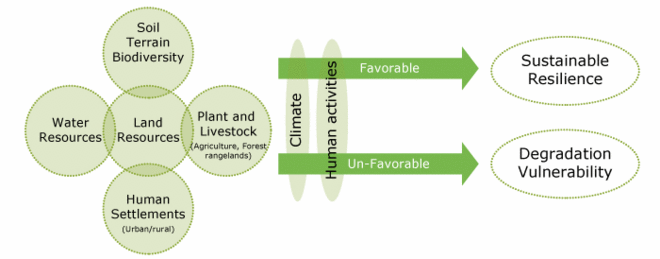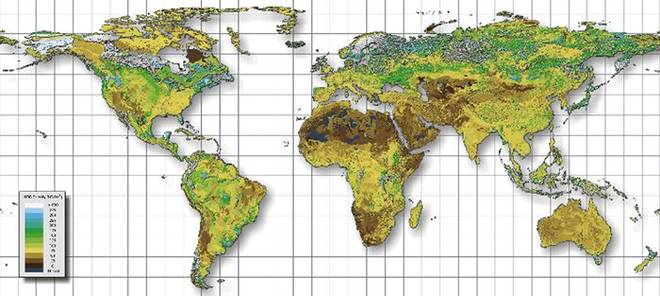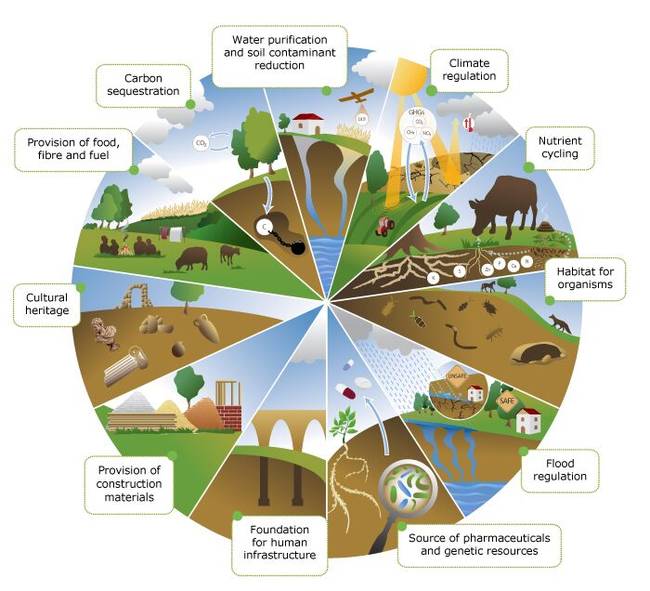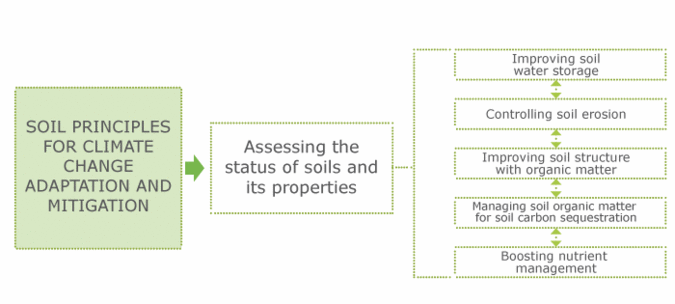Sustainable soil and land management and climate change
As a result of climate change, land degradation and losses in biodiversity, soil has become one of the world's most vulnerable resources (FAO and ITPS, 2015a and 2015b). Addressing soil and land degradation is a core challenge for sustainable development. Soil and land degradation has adverse impacts on ecosystem services that help safeguard food security, maintain water quality and availability, protect human health and establish the basis for a range of socio-economic activities. Sustainable soil and land management practices that are adapted to the local biophysical and socio-economic conditions can provide options for enhancing the interactions among soil, water, livestock and plants, which can prevent, slow or stop soil degradation and mitigate the impacts of climate change (Lal, 2013).
Sustainable land management refers to:
the use of land resources, including soil, water, animals and plants, for the production of goods to meet changing human needs, while simultaneously ensuring the long-term productive potential of these resources and the maintenance of their environmental functions (United Nations Earth Summit, 1992).
Sustainable land management includes measures that are suited to the specific biophysical and socio-economic conditions in a given area for the protection; promote the conservation and sustainable use of soil, water and and genetic diversity; and restore or rehabilitate degraded natural resources and revitalize the ecosystem functions.
Soil management is considered sustainable if:
the supporting, provisioning, regulating, and cultural services provided by soil are maintained or enhanced without significantly impairing either the soil functions that enable those services or biodiversity. The balance between the supporting and provisioning services for plant production and the regulating services of the soil provides for water quality and availability and for atmospheric greenhouse gas composition is a particular concern (FAO, 2015a, p.4).
Further definitions of relevant concepts are provided in Box B7.1.
Chapter B7-1.1 looks at the challenges that climate change presents for the sustainable management of soil and land resources. Chapter B7-1.2 considers the opportunities that sustainable soil and land management offers for fostering climate change adaptation and mitigation.
Box B7.1 Key concepts in sustainable soil and land management
Soili is the foundation on which plants establish themselves and grow, and the basis for crop, forest and livestock production. Soil provides nutrients and water that are taken up through plant roots and contribute to the hydrological cycle and atmospheric gases. The diversity of life and abundance of biological activity that exist within the soil are greater than those in any other terrestrial ecosystem.
Soil health is a precondition that enables the soil to provide the basic services for supporting plant growth and contributing to the regulation of nutrient, water, carbon and gaseous cycles. Soil health, and hence soil's productivity, are inextricably linked to its physical, chemical and biological properties. Of particular importance are its mineral composition, organic matter content, soil biodiversity and associated biological activity.
Land as defined by the United Nations:
is a delineable area of the earth’s terrestrial surface, encompassing all attributes of the biosphere immediately above or below this surface including those of the near-surface climate, the soil and terrain forms, the surface hydrology (including shallow lakes, rivers, marshes, and swamps), the near-surface sedimentary layers and associated groundwater reserve, the plant and animal populations, the human settlement pattern and physical results of past and present human activity, such as terracing, water storage or drainage structures, infrastructure, buildings (UN, 1994).
The interaction between the different components of land resources determines the productivity and sustainability of any land-use system (Ziadat and Bayu, 2015). Land productivity depends directly on soil productivity and health. Healthy soils provide plants with the support and nutrients they need to grow and provide the foundation for agricultural production systems. A favourable climate and suitable management are needed to sustain production and help withstand the impacts of climate change. An imbalance in one or more of the components of land resources and their interactions will reduce the production capacity of the agricultural ecosystem and increase its vulnerability to climate change (Figure B7.1).
Sustainable soil and land management practices provide options to manage soil, water, and plants, and their interactions under a specific set of biophysical and socio-economic conditions. Unfavourable climatic conditions, which may result from climate change and variability, coupled with the mismanagement or misuse of resources lead to degradation and vulnerability. Human activities can have a positive impact. For example, making a sound initial determination about how the land will be used and implementing sustainable land management practices will enhance sustainability and build resilience to change (Figure 7.1). Understanding which components of the land resources are at risk is vital for selecting and putting into practice the most efficient and affordable measures for reducing these risks. Land resources planning, which helps ensure that initial choices about land use are appropriate and subsequent soil and land management practices are sustainable, is an entry point for helping decision-makers and communities to achieve climate-smart land use.
Figure B7.1 - Land resource components

- Source: Authors
B7-1.1 The impacts of climate change impact on soil and land resources - the need for sustainable management
In cropping, grazing and forest systems, climate change and variability may affect soil health and its effects on plant growth in a number of ways.
- Reduced or erratic rainfall, and more frequent and severe periods of drought lower the capacity of soils to make water and nutrients available to plants.
- More intense extreme weather events, along with higher evaporation and transpiration rates, will lead to increased erosion by water and wind, and accelerated runoff; reduce groundwater recharge; and reduce the availability of soil moisture for plant growth.
- Higher soil surface temperatures will increase the rates of mineralization of soil organic matter and impair the soil’s capacity to sequester carbon and retain water, which will ultimately limit plant growth.
- Higher temperatures cause soil salinization and increase the evaporation rates and the accumulation of salts (e.g sodium chloride, calcium and magnesium sulfate and chloride) in the soil surface layers. Salinization can hinder plant growth and reduce yields on productive agricultural lands. High levels of soil salinity can be tolerated only if salt-tolerant (halophytic) plants are grown with properly managed irrigation and drainage systems. In almost every irrigated area in the world, the groundwater is affected to some extent by salinity (Palaniappan and Gleick, 2009; FAO, 2011). When there is a predominance of sodium ions, soils can become sodic. This presents particular challenges, as sodic soils tend to have very poor structure that limits or prevents water infiltration and drainage, and exacerbates the risk of water stagnation and erosion (see Chapter B7-3.2).
Some soil properties, such as soil textureii, are more resistant to change, or change very slowly over time. Other properties and functions, such as soil organic matter and soil organic carbon content (see Chapter B7-3.3), soil structureiii, base saturation and nutrient availability, soil organism populations, and pHiv, are more easily affected by environment changes, including those associated with climate, and prevailing land management. Soil organic carbon and carbon stocks above and below ground are included in the monitoring of Sustainable Development Goal indicator 15.3.1 for determining the proportion of land that is degraded out of the total land area. The physical properties of the soil affect how the soil will respond to climate change. These properties determine the proper management practices that need to be adopted to to maintain the delivery of soil ecosystem services, such as storing water, supplying nutrients to plants, sequestering carbon and reducing greenhouse gas emissions. Understanding these properties will enable agricultural producers and other land users to adapt to climate change and mitigate its impacts.
B7-1.2 The impacts of soil and land resources on climate change - the need for sustainable management
Soil hosts the largest terrestrial carbon pool, and the biogeochemical processes that take place in the soil regulate the exchange of greenhouse gases with the atmosphere (Scharlemann et al., 2014). These processes and emissions are strongly affected by land use, land-use change, vegetation cover and soil management (Chapter B7-2.1). The stocks of soil organic carbon in the upper soil layers are particularly responsive to these influences, and their careful management provides an opportunity to reduce the concentration of greenhouse gases in the atmosphere.
Sustainable crop, grazing and forest systems can sequester substantial amounts of carbon from the atmosphere and store it in soils and vegetation (Figure B7.2). The mechanisms underpinning terrestrial carbon sequestration are described in Box B7.3.
Sustainable soil and land management interventions that are designed to increase soil organic matter should be accompanied by actions that address the drivers of degradation and help preserve existing soil carbon stocks, particularly in soils with high soil organic carbon content (see Box B7.2) (Smith et al., 2014).
Figure B7.2. Estimates of global soil organic carbon (tonnes/ha of carbon) from the amended Harmonized World Soil Database.

- Source: Hiederer and Kocky, 2011
Carbon sequestration in soils will contribute to climate change adaptation and mitigation. It will also make agricultural production systems more sustainable; increase the overall resilience of agricultural ecosystems; and maintain the ecosystem services that are supported by soils (FAO and ITPS, 2015a; FAO, 2016a). The ecosystem services that the soil can provide and the soil functions that support these services are listed in the image below.

- Source: FAO, 2015b
There are many already proven soil management practices that can help farmers adapt to the likely adverse effects of increasing weather variability and climate change, and that can, in many cases, also reduce agricultural greenhouse gas emissions (see case study B7.1). The widespread adoption of these practices has the potential to make a major contribution to the achievement of national food security and development goals. Chapter B7-3 provides a summary of these practices. Figure B7.3 outlines the principles for climate change adaptation and mitigation on which these practices are based. Chapter B7-3 looks at the importance of assessing the needs and vulnerabilities of farming communities, and providing incentives for the adoption of sustainable agricultural systems with the greatest production, mitigation and adaptation potential.
Figure B7.3. Soil management to enhance climate change adaptation, mitigation and resilience.

- Source: Vargas, 2013

